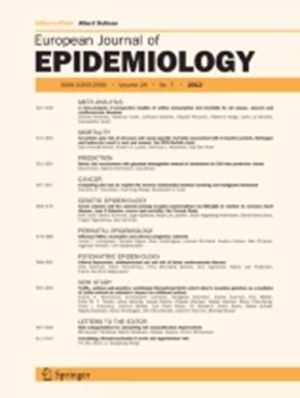Plasma metabolites, metabolic risk score and colorectal cancer risk: a prospective cohort study.
IF 5.9
1区 医学
Q1 PUBLIC, ENVIRONMENTAL & OCCUPATIONAL HEALTH
引用次数: 0
Abstract
The associations of colorectal cancer (CRC) risk with metabolites, lifestyle factors and their joint effects have not been fully elucidated. Therefore, we conducted a prospective cohort study to estimate the associations of CRC risk with metabolites, metabolic risk score (MRS) and its joint associations with lifestyle factors. This study included 82,514 participants with plasma metabolites data in the UK Biobank. LASSO-COX and Random Forest was used to select metabolites. Cox regression was utilized to construct MRS and estimate the associations of CRC risk with metabolites, MRS and its joint associations with lifestyle factors. Single-cell RNA sequencing data were analyzed to identify metabolism-related genes and metabolic pathways during CRC progression. During a median follow-up of 13.28 years, 1151 incident CRC cases were identified. MRS, constructed using 6 metabolites, was significantly associated with increased CRC risk (HR = 1.39, 95% CI 1.22-1.56 for high vs. low MRS), with the strongest association for proximal colon cancer (HR = 1.51, 95% CI 1.24-1.84), followed by distal colon cancer and rectal cancer (HR = 1.35, 95% CI 1.05-1.72; HR = 1.37, 95% CI 1.11-1.69). Joint associations were identified between MRS and lifestyle factors with CRC risk. Individuals with healthy sleep, never smoking, healthy diet, and healthy lifestyle but high MRS also exhibited elevated CRC risk. Linoleic acid, histidine and tyrosine metabolism pathways played important roles during normal intestinal mucosa to CRC progression. Pre-diagnostic metabolites and MRS were significantly associated with increased CRC risk, especially proximal colon cancer. Individuals should maintain normal metabolite levels and healthy lifestyles for CRC prevention.血浆代谢物、代谢风险评分和结直肠癌风险:一项前瞻性队列研究。
结直肠癌(CRC)风险与代谢物、生活方式因素及其联合效应的关系尚未完全阐明。因此,我们进行了一项前瞻性队列研究,以估计结直肠癌风险与代谢物、代谢风险评分(MRS)及其与生活方式因素的联合关系。这项研究包括82514名参与者,他们的血浆代谢物数据来自英国生物银行。使用LASSO-COX和Random Forest筛选代谢物。利用Cox回归构建MRS,估计CRC风险与代谢物、MRS及其与生活方式因素的联合关系。分析单细胞RNA测序数据,以确定CRC进展过程中的代谢相关基因和代谢途径。在中位随访13.28年期间,确定了1151例CRC病例。使用6种代谢物构建的MRS与CRC风险增加显著相关(高MRS vs低MRS的HR = 1.39, 95% CI 1.22-1.56),其中与近端结肠癌的相关性最强(HR = 1.51, 95% CI 1.24-1.84),其次是远端结肠癌和直肠癌(HR = 1.35, 95% CI 1.05-1.72; HR = 1.37, 95% CI 1.11-1.69)。MRS和生活方式因素与结直肠癌风险之间存在联合关联。睡眠健康、从不吸烟、饮食健康、生活方式健康但MRS较高的个体也表现出较高的结直肠癌风险。亚油酸、组氨酸和酪氨酸代谢途径在正常肠黏膜向结直肠癌进展过程中起重要作用。诊断前代谢物和MRS与结直肠癌风险增加显著相关,尤其是近端结肠癌。为了预防结直肠癌,个人应该保持正常的代谢物水平和健康的生活方式。
本文章由计算机程序翻译,如有差异,请以英文原文为准。
求助全文
约1分钟内获得全文
求助全文
来源期刊

European Journal of Epidemiology
医学-公共卫生、环境卫生与职业卫生
CiteScore
21.40
自引率
1.50%
发文量
109
审稿时长
6-12 weeks
期刊介绍:
The European Journal of Epidemiology, established in 1985, is a peer-reviewed publication that provides a platform for discussions on epidemiology in its broadest sense. It covers various aspects of epidemiologic research and statistical methods. The journal facilitates communication between researchers, educators, and practitioners in epidemiology, including those in clinical and community medicine. Contributions from diverse fields such as public health, preventive medicine, clinical medicine, health economics, and computational biology and data science, in relation to health and disease, are encouraged. While accepting submissions from all over the world, the journal particularly emphasizes European topics relevant to epidemiology. The published articles consist of empirical research findings, developments in methodology, and opinion pieces.
 求助内容:
求助内容: 应助结果提醒方式:
应助结果提醒方式:


